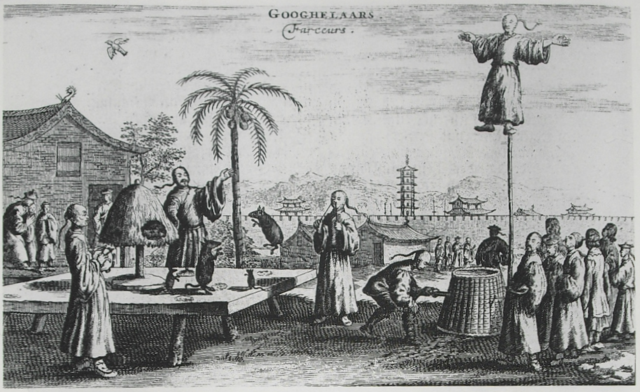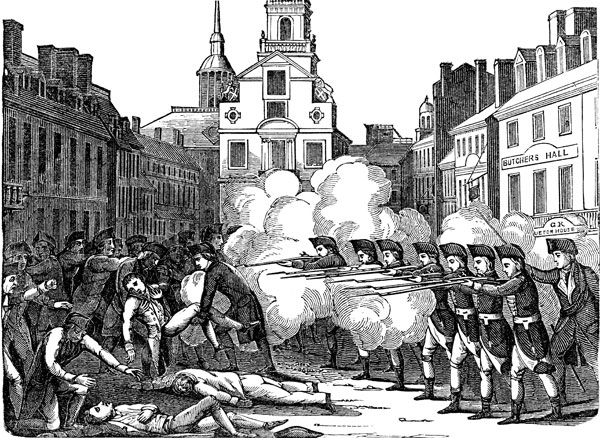The flag of the Great Qing.
Shortly after seizing the capital, Li Zicheng proclaimed himself the emperor of the newly established Qing dynasty. His first order of business was to seize the Mandate of Heaven by giving his Ming predecessor, the Chongzhen Emperor, a proper burial. Though his face was horrifically disfigured by numerous bee stings, he was given a public burial in the Imperial Palace, with both Manchus and Han Chinese in attendance. Li Zicheng informed the mourners that "The Late Chinese Emperor was brutally and terribly struck down in his garden when a beehive fell out of the tree he was sitting under and landed on his head." There were no beehives in the Imperial Garden.
Statue of Li Zicheng, the first Qing Emperor, outside of the Forbidden City.
However, barely a week after the funeral, Li's life was cut short as well when he failed to illuminate his room properly and was blown to pieces when a
creeper spawned next to his bed as he slept. He was succeeded as emperor by Dorgon, a general who had led many troops under Li.
That'sssss a very nice Empire you've got there...
Historically, the Manchus practiced a combination of Shamanism and ancestor worship, and this persisted well into the Qing era, despite the Qing court and much of the Han Chinese following predominantly Taoist philosophical beliefs. Shortly after ascending to the throne, Dorgon ordered a Shaman to enchant the Great Wall to give it similar Magical Sugar Plum Fairy Powers to those that had protected it from generic barbarians, with the goal of making it impassible to Mongols as well. Upon completion of the ceremony the Shaman entered the palace and informed the Emperor simply that "The Walls have eyes now."
The Dorgon Emperor proved an able negotiator, and quickly consolidated his control over China. He rooted out Ming pretenders in the south, and labeled them as anarchists, before using both Han Chinese and Manchu troops to crush them and insure their loyalty to his empire. He also enforced a controversial rule in 1620 requiring all men to wear their hair in a queue, on pain of death. Though some protested this new hairstyle, Dorgon quashed any dissent by displaying a picture of Philip IV of Spain as a reminder that things could be much, much worse. After nearly 40 years of rule, the Dorgon emperor's reign was finally ended at the age of 68 when he was killed in a bizarre hunting accident in which one of his aides "thought he was a rabbit" and
accidentally shot him in the face with an arrow. He was succeeded by the militaristic Shunzhi, who ascended to the throne in 1642.
An example of Chinese men wearing their hair in the mandatory queued style as prescribed by the emperor Dorgon.
Not long after ascending the throne, Shunzhi turned his gaze to the north, to the struggling Kingdom of Eastern Mongolia. The small kingdom had been established in response to the Mongolian government's constant (and rarely successful) warring with Ming China, which had devastated the country's infrastructure and had depleted much of its military. With its once-feared horde a thing of the past, the Khan could do little but watch as the entire half of his country seceded and became an independent state, with its capitol at Choibalsan. Initially, the fledgling Kingdom worked closely with the Ming Dynasty, as both treated what remained of the Mongol Empire to the west with disdain. However, such agreements were no longer necessary due to the new Qing enchantments of the great wall, and, blaming the Dorgon Emperor's shooting death on Eastern Mongolian guerrillas, Shunzhi declared war on the relatively weak nation.
The city fell in quick order, with the Qing emperor opting to sinocize the name rather than keep the old one or give it a new Manchu title. In 1644, Qiaobashan was the newest city to be added to the vast expanse of Qing China. The sacking of the city sent much of its Mongolian population fleeing back west into Mongolia, the dream of an independent Eastern state now shattered. In effect, this had a similar result as the Manchu immigrations into northern China had on the Ming just forty years earlier. However, Mongolia was even more badly damaged by their frequent battles with China, and later their futile attempts to maintain control of the East. The countless new refugees proved to be too much for the Empire's shattered economy to bear, and anarchy soon broke out. With Karakorum in flames, the last Mongol ruler, Ligden Khan, fled the capital in 1651AD. With several independent factions vying for control of the West, Mongolia ceased to be a sovereign power, and its people for the most part reverted to their earlier nomadic lifestyles. Finally, barbarian raids from the north were a thing of the past.
However, the Qing officials had little time to breathe a sigh of relief before another threat emerged: the Tokugawa Shogunate. Throughout the Qing conquest of Qiaobashan and the subsequent Mongol collapse, the Shoguns of Japan had looked on with disdain, as it seemed that the new Manchu leadership of China would be unstoppable with no one to check its power, save for the Muslim Tsars of Russia who had recently begun to colonize the vast reaches of Siberia to the North. Still reeling from the loss of its Persian territories, the Bakufu was eager to acquire new lands at the expense of what was at the time one of the largest empires in the world. Barely six months after the collapse of the Mongolian Khanate, Tokugawa Iemitsu declared war on the Great Qing.
Despite this declaration, Japan never deployed troops to China, as the Qing had moved a significant military force to the edge of Manchuria now that the Mongol threat had ceased. Within the empire, life went on as normal. Shunzhi enjoyed a long and fruitful reign, as he attempted to integrate Chinese and Manchu culture both in and out of his court. As an example of this, he oversaw the completion of the Forbidden City in Wuzhou in 1659. It would serve as a great center of Chinese culture, as only Han Chinese were allowed inside, in an effort to "preserve" a culture which Shunzhi feared would be lost otherwise. Although this was an attempt to gain favor with the Chinese population (who still had qualms about having to tie their hair into annoying ponytails), the establishment of the forbidden city did little in this regard, and was eventually turned into a museum of Han culture.
The "war" with Japan lasted for 12 years, although no actual battles took place and the conflict was resolved without any actual bloodshed occurring. In 1663, Shunzhi sent an aide to Tokugawa's castle, with the understanding that, as a messenger for his empire, he would not be fired upon. He was going to negotiate with Iemitsu himself about not only ending the war, but possibly entering in an alliance against Russia and the other remaining powers in Asia.
Then he took an arrow to the knee.
After mistaking the messenger for a threat and having him killed by one of his guards, Tokugawa hastily sent an envoy to China to apologize for the error. Along with the envoy was sent 180 fat gold pieces as a "Token of Apology" as the Shogun put it. Shunzhi was eager for the phony war to end, and accepted the deal. After all, the Empire had far more pressing issues.
In 1671, a purplish rash appeared on Shunzhi's arm. A year later, he was dead, one of the first documented victims of Smallpox in East Asia. By 1675, every major city in China was afflicted with the disease, and in some areas nearly half of the population was wiped out. The scourge failed to differentiate between Manchu and Han, and the two ethnic groups ceased civil hostilities altogether in the face of this common threat after Shunzhi, in the last weeks of his life, assured the Chinese people that the Manchu immigrants were not responsible for the disease. However, with his death and the subsequent spread of the infection through all but the most remote villages in China, it seemed as though the Qing Dynasty might come to a brutal and sickly end.
However, in the Qing Empire's darkest hour, a new emperor rose to save the Dynasty from destruction. All of Shunzhi's sons had contracted the plague, and one by one they joined their father in the heavens. However, Shunzhi's third son, Xuanye, made a miraculous recovery, and ascended the throne in 1678. Thus began the illustrious reign of the Kangxi Emperor.
Xuanye, reigning as the Emperor Kangxi.
The "High Qing," as the Qing Empire under Kangxi came to be known, was named in part for the cultivation of hemp within the southern portions of China, which began largely under Xuanye's reign. Under Kangxi, a great amount of scientific advances occurred, such as the discovery of gunpowder. Kangxi immediately ordered that his pyrotechnicians find a way of launching this new substance into the air, and modifying its makeup so that he would have something interesting to watch while he was high. Thus, the world's first fireworks were developed during his reign. However, Kangxi realized the combat effectiveness of such an explosive powder, and ordered that it be put to use in the Qing military, to ensure that no one would be able to rival China's military might. The cannon was born.
Just when things seemed to be looking up, the Emperor received another blessing. The Islamic Tsardom of Russia, long considered to be one of the most powerful countries in the world, suddenly found itself bankrupt, having spent countless Rubles on settlements in the empty reaches of Siberia, with the goals of sending such luxury items as fur and gems to Moscow without having to pay steep dividends in trade. However, due to the vast distance between Siberia and the west, and due to the lack of roads connecting the two, few goods made it to their intended destination. Over time, Siberia became de-facto independent of the Tsars of Moscow, rejecting Islamist teachings and the Russian language, while reverting to more localized ways of life. Over-expansion had taken a deadly toll on Russia, and the Tsardom was dissolved in the Spring of 1705, with Nationalistic, Anarchist, and Islamist factions vying for control of Moscow. For the first time since the formation of the Khmer Empire over a thousand years earlier, Japan and China found themselves as the sole heirs to real power in Asia.
With Russia gone, none remained to check Qing power in central Asia. In 1716, the aging Kangxi emperor gave the go-ahead for the "liberation" of Mongolia from the "barbarians" who had controlled the lawless territory since the fall of the Khanate. The first target on his list was the ancient capital of Karakorum, which Chinese troops had never been able to breach. However, with the invention of powerful Chinese muskets, the Qing forces were able to tear through the city's defenses with no trouble, as cannons tore a wide hole in the ailing city walls. Eager to symbolically defeat China's northern enemies once and for all, Kangxi gave the order for the city to be torched and its population massacred.
Domestically, the Kangxi emperor strove to eliminate opposition to the Sino-Manchu way of life that he viewed as the ideal. The final challenge of his reign was the spread of Christianity into his lands. Protestantism, a new, uniquely British brand of Christianity, had been established in London, in response to the Catholic Church, which had been all but hijacked by the French consulate in Rome. On Christmas Eve 1718, happy British Missionaries arrived in Tibet from British India, and established an embassy with the goal of spreading holiday cheer and teaching the Chinese about Christ's message of love and peace. The next day, they were all shot to death by Qing soldiers.
British artist's rendition of English missionaries being horrifically slaughtered by Qing officials on Decmber 25th, 1718, in what would later be known as the "Lasa Massacre".
In 1722, Kangxi finally succumbed to lung cancer. His son, Yong, sought to continue his father's largely successful imperialistic policies. Under Yong, now known as the Yongzheng Emperor, more artillery regiments were sent north, to destroy the last former Mongolian stronghold of Irkutsk. By 1730, the lands around the ruins of the former Mongolian capital were largely depopulated, and Qing troops encountered little resistance as they charged northwards.
As was now the norm, the feared Qing soldiers burned the city to the ground and killed many of its inhabitants. However, this time around, the troops were allowed to take prisoners, and those who surrendered were relocated south, to a new "re-education" village on the far western shore of Lake Baikal, closer to the Qing border.
Under the reign of Yongzheng and his son Qianlong, the Qing Dynasty finally recovered from its smallpox epidemic and indeed grew a great deal. By the middle of the 18th century, the Qing controlled Eastern China, Tibet, Xinjiang, Taiwan, Lelang, Jiaozhi, and Mongolia, with a population well over 20,000,000.
Qianlong, unlike his predecessors, was less wary of western influence in his empire, and restored trade contacts with the west. To his surprise, he found that the once mighty French Empire had long since crumbled, and that Portugal and the Netherlands had eagerly scooped up the remains.
Although Qianlong's reign coincided with one of the greatest eras of prosperity in China's history, Qing power began to decline in the late 18th century. Corruption was rampant, and Qianlong began to accept to bribes and threats from inside and outside his domain. In 1756, the Tokugawa shogunate "requested" that China cut off its trade contacts with the west and introduce a new system of trade favoring an "Asian Brotherhood" between the two main powers of the east. Unbeknowest to the Japanese, however, the Qing were greatly feared in the west. Whereas the Ming had been considered cultured and admirable, the Qing were largely viewed as barbarians, especially after the Lasa Massacre.
Although the peak of Qing power had passed, more technological advances occurred under Qianlong. The late 18th century marked the beginning of the renaissance era, and Qianlong immediately dispatched his top researchers to figure out what in the world that device in the picture is. Although many of Qianlong's advisors believed it to be the love-child of a demented compass that had sex with a menorah, no one could be sure.
The second blow to Qing power came when Qing explorers made contact with an upstart nation calling itself "The United States of America". They were led by the general George Washington, who was 150 years old and had no idea what was going on. Ultimately, it would be American ideas of democracy and republicanism that would contribute greatly to the decline of the Qing.
Like the Independent Empire, the Native Empire too controlled great amounts of land, although they mainly laid claim to the old Swahili city states and the Duchy of Yucatan. Although no one in the Qing leadership realized they were actually at war, they eagerly welcomed a native diplomat who arrived in Beijing on a peacekeeping mission in the late 18th century.
Around this time the Ottoman Empire dissolved itself for some reason, but the Qing were too preoccupied with their own internal problems to care, and Portugal and the Dutch were too busy being awesome, so nobody noticed.
Despite the economic impacts of dealing with such a large empire, Qianlong's son, Jiaqing, was even more power-hungry and corrupt than his predecessors, and aimed to create a "Greater Sino-Manchurian Empire" at the expense of the Japanese, who still laid claim to the Manchu homeland. As he readied one of the largest military forces in history for an assault on Manchukuo, Jiaqing reveled in his own assurance that as long as the Great Qing continued to expand, it would remain prosperous and would certainly never go the way of the Arabs, the Russians, and so many other great world powers before it.
His prediction would soon prove to be disastrously wrong.











 = Mongolia
= Mongolia = Russia
= Russia


































